#Shima Sakon
Text

Gakuen Basara ^^
#sengoku basara#gakuen basara#senbasa#BASARA#SenBasa#tokugawa ieyasu#shima sakon#ishida mitsunari#ieyasu#sakon#mitsunari#戦国basara#学園BASARA
15 notes
·
View notes
Text
need a sakon route asap, or an event
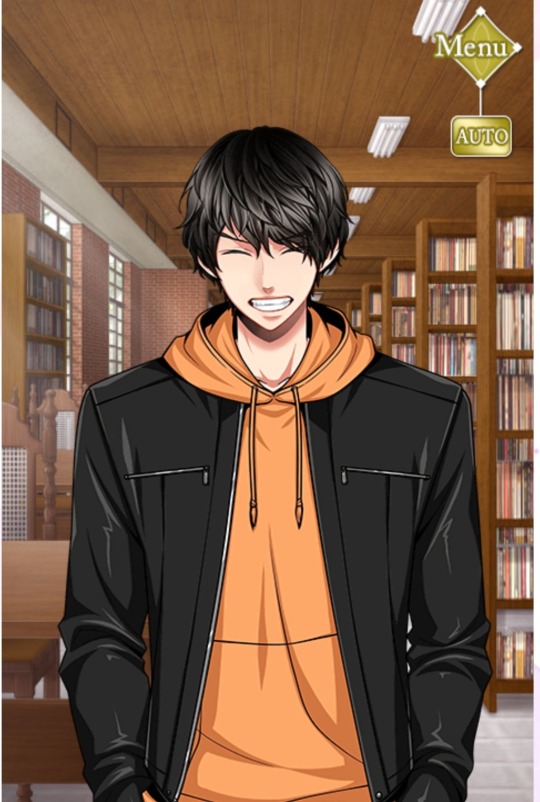
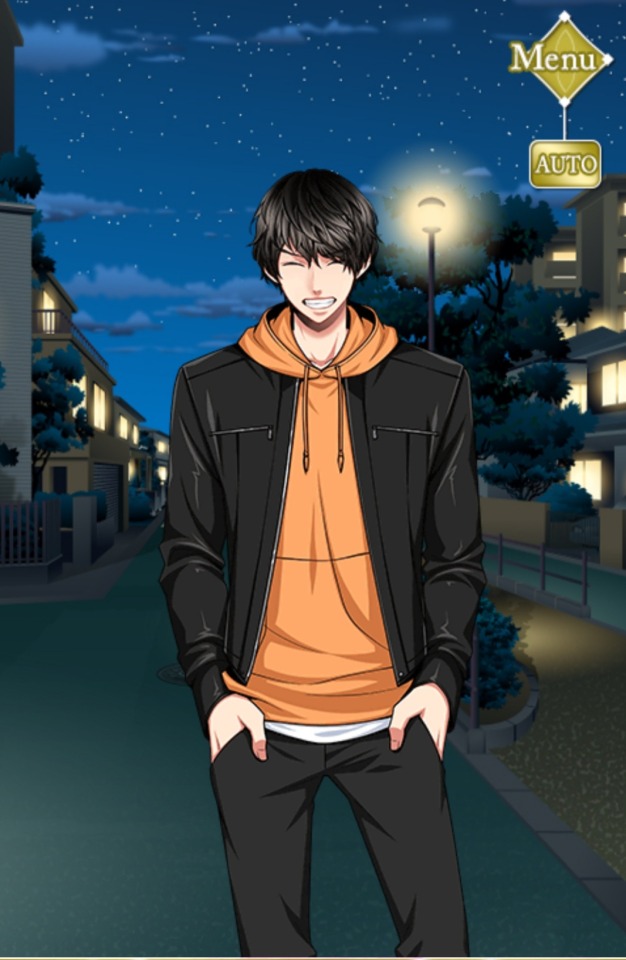
6 notes
·
View notes
Photo
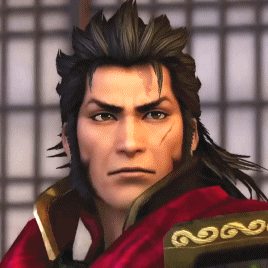
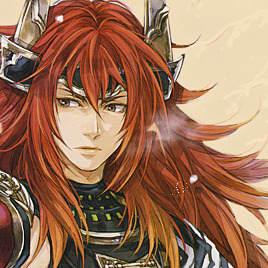

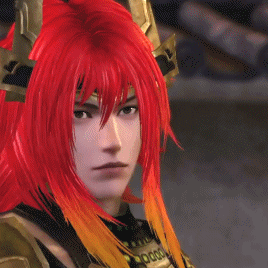
Endless KOEI ships - SW4 - Sakon/Mitsunari
#samurai warriors#sengoku musou#ishida mitsunari#shima sakon#bell making silly gifs#gif#losing my mind at their sw4-ii ending rn
31 notes
·
View notes
Photo

sengoku basara plushies by gift(yes, they’re the same company that made the fumos)
#sengoku basara#date masamune#katakura kojuro#sanada yukimura#sarutobi sasuke#ishida mitsunari#shima sakon#plushies#anime plush
19 notes
·
View notes
Text
I will continually post any and all Sengoku Basara jokes I can edit into existence as long as I live.
2 notes
·
View notes
Text
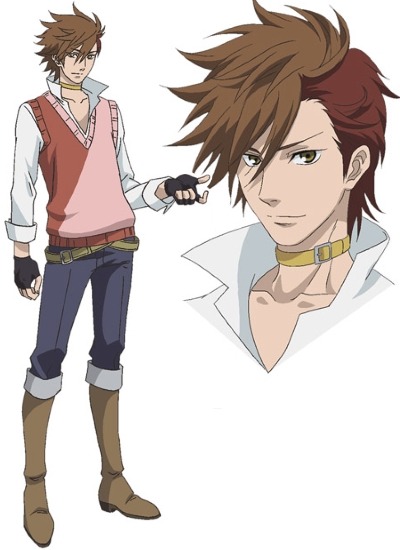
Gakuen Basara - Shima Sakon
1 note
·
View note
Text
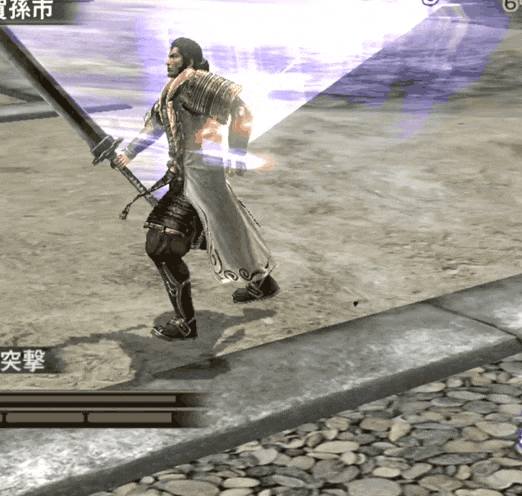

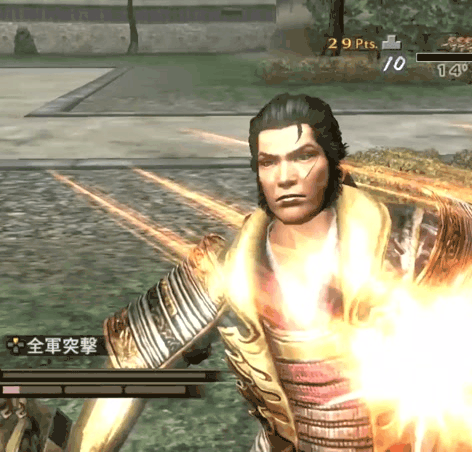
Sakon dizzily spins his little head and pathetically faints~
0 notes
Text
Misery: Katsuie
CPR: Kiyomasa
Reese’s Puffs: Sakon
Alternatively...
Misery: Mitsunari
CPR: Yoshitsugu
Reese’s Puffs: Sakon
#Sengoku Basara#Shibata Katsuie#Kato Kiyomasa#Shima Sakon#Ishida Mitsunari#Otani Yoshitsugu#Crack#That's it. That's the post.#Now that I've gotten that out of my head I'm logging out of Tumblr and going back to retweeting TW///ST fanart. XD
1 note
·
View note
Photo
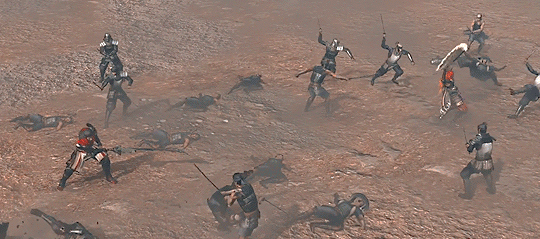





#sakon shima#mitsunari ishida#samurai warriors#sengoku musou#samurai warriors 4#sw#sw4#sw;gifs#gif#ktedits
36 notes
·
View notes
Text
Sakon Shima
1. The Elvis shtick they had going for him in SW2 was weird, and I’m happy they mostly tossed that out in subsequent games. He’s a cool “older” guy who’s mostly calm and collected and wants to have some fun, too.
2. Mitsunari. I don’t think anyone is better suited for Sakon than Mitsunari, whether you all like them romantic, platonic, or whatever, I think they’re just soulmates. Though I won’t lie, I was very amused by Sakon flirting with Zhuge Dan in WO3
3. Hmm...idk does Sakon really interact with anyone outside of Mitsunari? Oh wait, Sima Zhao! Yeah him and Zhao had a cool friendship going on in WO3.
4. Hmm...as I mentioned, the Elvis thing was weird and I’m glad they got rid of it, sorry for the fans who liked that persona. I don’t really have anything negative to say about him, he’s not really one of my favorites, but I don’t dislike him either
2 notes
·
View notes
Text
Mitsunari joins the 'suddenly gets 2 vassals we didn't know existed' gang with his eternal route. Their names are Shima Sakon and Watanabe Shinnojou.
They handle affairs at Mitsunari's castle (Sawayama Castle) while he's away
Shinnojou has short hair and dignified features. Quite handsome and is popular with women.
Sakon is more muscular, has his hair tied back, and speaks in a very very very old fashioned samurai style (his personal pronoun is 某 それがし). He looks quite stern.
Sakon like sake, Shinnojou likes manjuu.
According to Hideyoshi, they were both very accomplished warlords in their own right and hated the thought of being subordinate to anyone. Hideyoshi had asked them to work for him but they refused, deciding to serve Mitsunari instead. That's part of the reason why some people are envious of Mitsunari.
They bicker a lot. But also are like 100% committed to serving Mitsunari. When Mitsunari asks them to prepare a banquet so he can introduce Mai to everyone, they both literally break into a run to head to the castle to prepare for it (also since it's the first time Mitsunari ever suggested holding a banquet, ever)
Mitsunari doesn't refer to them with honorifics like he does with every other character, which shocks Mai. This was by request--they put clauses into their employment contracts that Mitsunari should not use honorifics for them.
As for the actual reason why: they were both famous enough for Hideyoshi to want them as his vassals. Mitsunari at that time had no qualifications or any reputation to speak of. It would have made him look even worse in the eyes of others if he was speaking so deferentially to people who were supposed to be his vassals. So the two of them made sure to get Mitsunari to speak casually to them in order to improve his reputation in the eyes of others.
41 notes
·
View notes
Photo
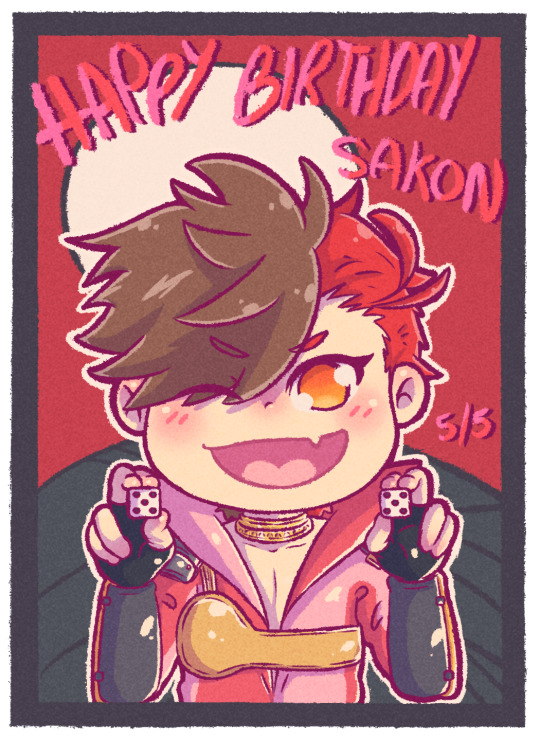
Late but Happy Birthday Sakon-chan ^^
(๑Wڡ`๑)
15 notes
·
View notes
Text


Sakon with hair down is my fav... Haha I forgot he fell for Saki AKA Mitsunari in the latter's MS
4 notes
·
View notes
Text

March 29: Happy 58th Birthday to Voice Actor Brian Beacock, who provided the English voices of the characters of Yumichika Ayasegawa on Bleach, Renzo Shima on Blue Exorcist, and both Sakon and Ukon on Naruto and later as Chojiro on both Naruto Shippuden and Boruto: Naruto Next Generations.
#Voice Actor#Brian Beacock#Bleach#Blue Exorcist#Naruto#Naruto Shippuden#Boruto Naruto Next Generations#Anime and Manga#Fandom Birthday#March 29 Birthdays
4 notes
·
View notes
Text
Nampō Roku, Book 7 (80): Concerning Lord Hino’s¹ Use of Kayari [蚊遣]² in the Roji.

80) Concerning [his connection with] Rikyū-koji, Hino Terusuke had become his disciple, and [they] frequently visited [each other]³.
On an evening in the summer, [Terusuke] set up a kayari-bi [蚊遣火] in his garden, in the shade under the trees⁴. When [Ri]kyū saw this [he said] “indeed, isn’t that most tasteful!” -- he was deeply moved⁵.
Since then [it has become the practice that], in a secluded place in the roji [and] near the koshi-kake, in a suitable place in the shade under the trees, the kayari should be set to smoldering [in order to keep the area free of mosquitoes]⁶.
_________________________
◎ The toku-shu shahon version of this entry agrees with the Enkaku-ji manuscript. However, according to both Tanaka Senshō and Shibayama Fugen -- and rather curiously -- the genpon text substitutes the name of Lord Asukai [飛鳥井殿] (perhaps Asukai Masakata [飛鳥井雅賢; 1585 ~ 1626], who held the lower grade of the junior fourth rank, and was Sakon-e no shosho [左近衛少将], equivalent to lieutenant-general of the Sakon [Left] Guards unit) for that of Hino Terusuke [日野輝資; 1555 ~ 1623]. This is strange because, while Lord Hino is known to have been a disciple of Rikyū (he is mentioned several times in the Nampō Roku in this capacity), a connection between Rikyū and Lord Asukai is less well documented*.
___________
*In 1609, Asakai Masakata was exiled to Naka-no-shima [中之島] in Oki [隠岐] (a group of islands northwest of the border between Tottori and Shimane Prefectures) on account of having seduced one of the emperor’s ladies-in-waiting. Masakata died in exile later in 1626.
Masakata is not recorded to have had any interest in chanoyu, and there does not appear any other reason to associate Masakata with Rikyū.
The Asakai family was established during the Heian period, but they were always more closely associated with waka [和歌] and kemari [蹴鞠] than with other cultural activities. (Kemari, which appeared in something resembling its present form toward the end of the Heian period, is usually described as a kind of football; but the object of the game was to keep the ball in the air, and prevent it from touching the ground: after kicking the ball, that player had to intone an original waka before the ball was kicked again. As can be seen below, the participants usually wore casual court dress, as well as their lacquered caps of estate.)
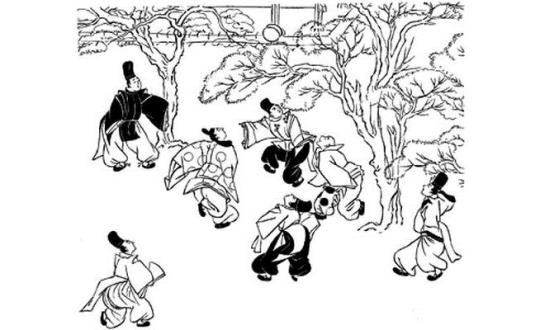
Members of the Asakai family were the instructors of kemari to the Ashikaga shōgun Yoshimasa and Yoshinao, and their courts. During the fifteenth century the Asakai also founded the Niraku school [二楽流] of calligraphy. Their fortunes seem to have declined in tandem with those of the Ashikaga house, so that they were remembered more for the scandal involving Masakata, than for other accomplishments during the sixteenth and seventeenth centuries.
¹Hino Terusuke [日野輝資; 1555 ~ 1623] was a scion of the hereditary court nobility (kuge [公卿]), who served in various governmental posts, ultimately being appointed Gon-dainagon [権大納言] (Supernumerary Grand Counselor of State) in 1597, at which time he was elevated to the senior grade of the Second Rank. He was thus the highest ranking among Rikyū's noble disciples.
Terusuke retired from government service in the Fifth Month of Keichō 12 [慶長十二年] (1607) and became nyūdō, taking the name Yuishin-in [唯心院]. Nevertheless, it seems that he remained a counselor to both Tokugawa Ieyasu and his son Hidetada until his death.
²Kayari [蚊遣] means mosquito repellent, and usually referred to burning pine-needles or dried mugwort (or an incense compounded from the latter) for this purpose. The practice had been employed at the Imperial Court since ancient times, but this occasion appears to have been the first time that it was used in the roji -- to rid the roji and koshi-kake of mosquitos during a chakai.
³Rikyū-koji ha, Hino Terusuke no montei ni natte, tsune ni mairare-keri [利休居士ハ、日野輝資ノ門弟ニ成テ、常ニ參ラレケリ].
Rikyū-koji ha [利休居士は] means concerning Rikyū-koji.
Koji [居士] was the “non-title” (meaning a Buddhist layman, or lay believer -- that is, a follower who had not formally taken the tonsure) that was bestowed on Rikyū in early 1586, so he could enter the Imperial Palace and assist* Hideyoshi’s service of tea to the Emperor Ōgimachi [正親町天皇; 1517 ~ 1593 -- his reign extended from the 27th day of the Tenth Month of Kōji 3 [弘治三年], 1557, to the 7th day of the Eleventh Month of Tenshō 14 [天正十四年], 1586] in Hideyoshi’s golden tearoom (which was set up on the deep veranda of one of the halls within the palace compound).
Hino Terusuke no montei ni natte [日野輝資の門弟になって]: this phrase is grammatically irregular; but the meaning seems to be that Hino Terusuke was one of Rikyū’s disciples†.
Tsune ni mairare-keri [常に參られけり] means that (he) frequently desired to visit‡ -- while this is usually understood to mean that Terusuke often visited Rikyū, the context of this entry implies that the visits between the two were reciprocal.
Here, and throughout the entire passage, he toku-shu shahon agrees exactly with the Enkaku-ji text**.
___________
*Despite occasional assertions to the contrary that are found in the popular tea histories, Rikyū’s job on this occasion was primarily to grind the tea, help prepare the utensils, and take care of various things that had to be done in the preparation area (such as emptying the koboshi, and returning it after cleaning, so Hideyoshi could replace it on the daisu), and sit in the vicinity of the sadō-guchi, ready to offer any advice that Hideyoshi might have needed. The surviving accounts suggest that the daisu-temae that Hideyoshi employed on this occasion used a bon-chaire and dai-temmoku, and everything used was either made of gold, or made of wood covered with gold (the temmoku was made in that way, since a gilded ceramic bowl would have been too heavy, and potentially could have been too hot to hold comfortably).
On this occasion, Rikyū did not meet the Emperor or serve him tea while Hideyoshi sat and chatted with the Emperor (the way some popular versions of the story suggest). Indeed, the Emperor would have been entirely unaware of Rikyū’s presence.
†Linguistically, the construction of this phrase seems to suggest that Rikyū became Lord Hino’s disciple, which is nonsense.
‡The suffix -keri [けり] might be interpreted to suggest that this was something that happened in the past, something that had already ceased to occur by the time that this text was written down.
And, indeed, as Lord Hino rose higher and higher in the government, he would have had correspondingly less time to indulge in things like chanoyu.
**As does the genpon text -- except that, as noted above, the genpon version inserts the name Asukai-dono [飛鳥井殿], Lord Asukai, in place of Hino Terusuke [日野輝資]: Rikyū-koji ha, Asukai-dono no montei ni natte, tsune ni mairare-keri [利休居士ハ、飛鳥井殿ノ門弟ニ成テ、常ニ參ラレケリ].
There does not seem to be any historical justification that might account for this change in the text, however, so it is difficult to imagine how the substitution came to be made by the editors of the genpon edition. Tanaka Senshō, however, argues that the reason for the name change was because of the Asakai family’s traditional connection with kemari (that was mentioned in the sub-note below my introduction). Because the Asakai were the national experts, the men of their family would have had to practice kemari out-of-doors throughout the year. During the summer months, because of the discomfort caused by mosquitoes (not only while playing, but also while resting between innings in the shade of the trees in the garden), they began to burn mosquito repellent in the garden to make their long practice sessions more endurable. Nevertheless, this does not give us any clues as to why Rikyū would have been visiting them, or why he would have been so deeply impressed by the idea of burning kayari in the garden.
⁴Natsu yū-gata, o-niwa no ko-kage ni kayari-bi wo tateraretari wo [夏ノ夕方、御庭ノ木陰ニ蚊遣火ヲタテラレタルヲ].
Natsu yū-gata [夏の夕方] means on an evening during the summer.
O-niwa [御庭]: the honorific o- [御] was probably used because Lord Hino was a member of the kuge [公卿], the hereditary court nobility, so the use of the polite form would indicate unambiguously that this garden was in his residence.
O-niwa no ko-kage ni kayari-bi wo tateraretari wo [御庭の木陰に蚊遣火を立てられたるを] means that in (Lord Hino’s) garden, in the shade of the trees*, a kayari-bi [蚊遣火]† was set up.
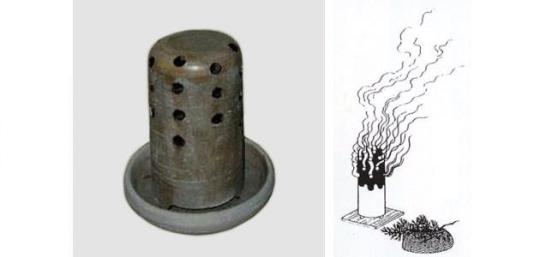
A kayari-bi was an openwork (usually ceramic) brazier (an Edo-period example of a kayari-bi that was made to be set on the floor of a room is shown above) in which either dried pine-needles, or stalks of dried mugwort (Artemisia princeps, and possibly other species)‡, were set to smoldering, since the smoke from these plants had mosquito-repelling properties.
However, by the point in the Edo period when this text was written, mosquito-repellent incense sticks (katori-senkō [蚊取線香]**), made from crushed mugwort mixed with charcoal powder, also seem to have been invented, so this entry could be referring to either form of kayari.
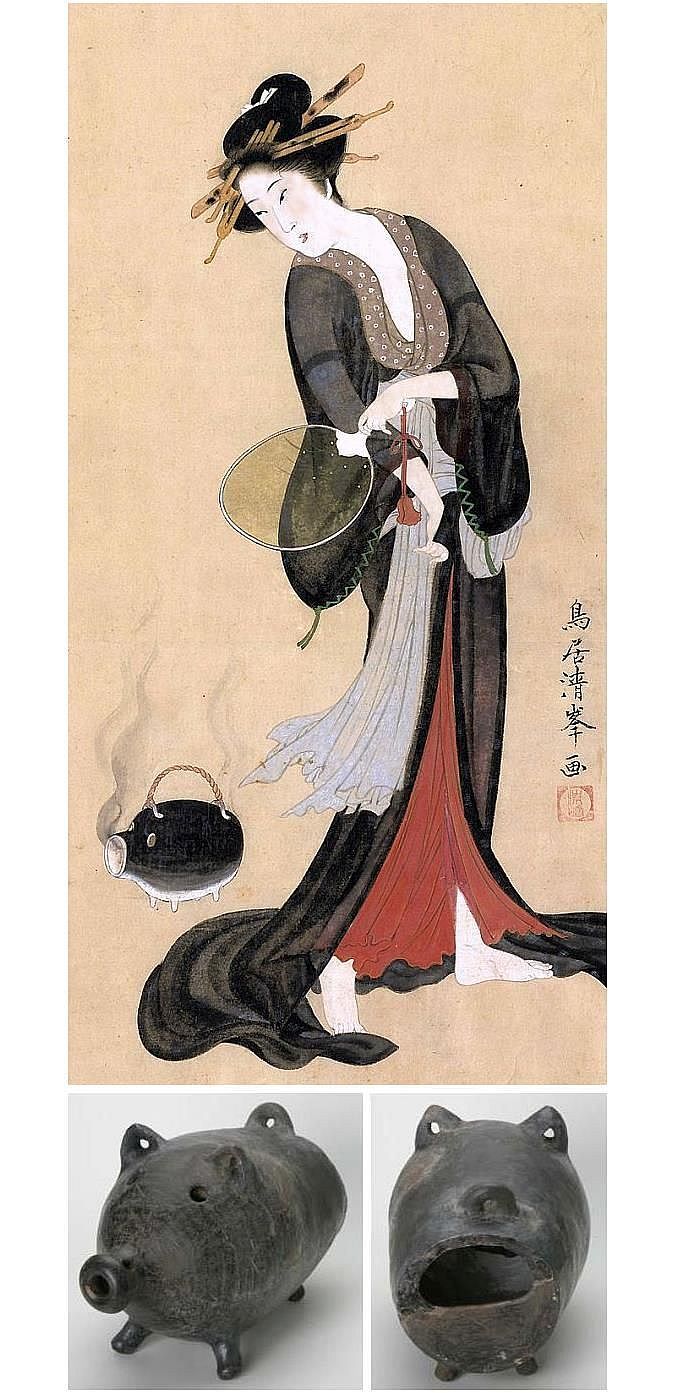
The above painting, titled Kayari-bijin [蚊遣美人] (“a Beauty with a kayari-bi”), by Torii Kiyomine [鳥居清峯; 1836 ~ 1867] shows how a handle was attached to another Edo-period example of a katori-bi (an antique example is shown below the painting -- the pine-needles, stalks of mugwort, or a coil of mosquito incense, would be placed inside through the large hole in the back side of the kayari-bi). The handle was used to carry the kayari-bi from place to place, as needed, to keep the mosquitos away††.
__________
*Since the gathering during which this kayari-bi was set up in the roji was held in the evening, the shade from the trees is probably less important to the story than the fact that the kayari-bi was placed somewhere where it would not be seen. The purpose was, of course, to chase away the mosquitoes and other night insects from the vicinity of the koshi-kake and roji.
†With respect to this use of a kayari-bi in the roji, Tanaka Senshō comments:
Kayari de naku, eji-kago tote, niwa no tsūro ni kō wo taku-koto ha ko-rai aru. Ka no dō no tsuru ya, kamo nado wo tei-jō ni oite kō wo taku-koto ha, ko-rai okonawareta-koto de aru. Kono-koto kara, kayari wo omoi-tsuita no de arau ka. Roji ni kayari wo tateta-koto ha, mukashi to shite omoshiroi shu-mi de aru. Ima-doki ha, ryōri-ya no teien ni, katori-senkō ga takarete-iru ga, kore ha fūryū to ha ienu. Yahari, eji-kago nado suete, mukashi-fū no kayari-bi no kata ga omoshiroi to omou
[蚊遣でなく、衛士籠とて、庭の通路に香を炷く事は古来ある。彼の銅の鶴や、鴨抔を庭上に置いて香を炷く事は、古来行われた事である。此事から、蚊遣を思ひ付いたのであらうか。露地に蚊遣を立てた事は、昔として面白い趣味である。今時は、料理屋の庭園に、蚊取線香が炷かれているが、是は風流とは云ヘぬ。やはり、衛士籠抔据ゑて、昔風の蚊遣り火の方が面白いと思ふ].
“In the absence of a kayari, since ancient times it has been the practice that even [something like] an eji-kago [衛士籠] might be set up beside the garden path and used for burning incense. As for placing bronze cranes and ducks and the like in the garden for burning incense [to perfume the air], this has been done since ancient times. Perhaps this was how they came up with the idea of [burning] kayari? Setting up the kayari in the roji must have been a interesting way to amuse [oneself] in bygone days. Nowadays, katori-senkō is burned in the gardens of restaurants, but [I don’t] think this can be called tasteful. I think it would be much more interesting to set up an eji-kago and make use of this old-fashioned way of repelling mosquitos!”
An eji-kago [衛士籠] (the name means a sentry’s/gatekeeper’s basket -- by the light of which the guard was able to identify people approaching the gate for admittance) was (originally) an iron basket, suspended from or on some sort of stand or tripod (as can be seen below), in which wood was kindled for illumination. This arrangement was also referred to as a kagari-bi [篝火] -- as in the following Edo period illustration for chapter 54 of the Genji monogatari [源氏物語] (which sets the scene on a veranda whose garden is illuminated in this way). In the picture we see a line of kagari-bi (often translated as “flares”) set up along the bank of the garden stream, with the fires attended by underlings.
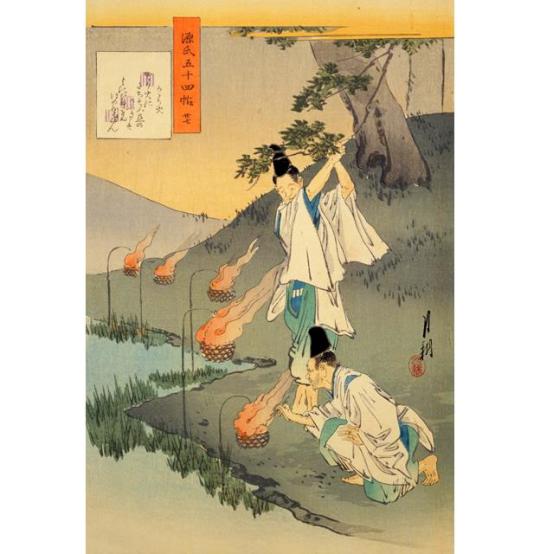
Here, it is unclear whether Tanaka believed that the smoke from the fire in the kagari-bi would be sufficient to drive the mosquitoes away, or whether he is using the word eji-kago to refer to a similar sort of arrangement -- albeit one in which pine needles or mugwort, or some other special material, would be burned in similar manner to produce the desired fumigatory or mosquito-repelling effect.
The reference that he makes to bronze cranes and ducks installed in the garden is either addressing the matter of the supports from which the containers of smoldering incense (usually crushed jin-kō [沈香] or kyara [伽羅], or blends based on these) were suspended (the bowls were taken in when incense was not being burned, leaving the bronze statues standing in the garden as decorative objects in their own right), or to bronze censors cast in these shapes (such as the one shown below) that were set out in the garden to perfume the air.
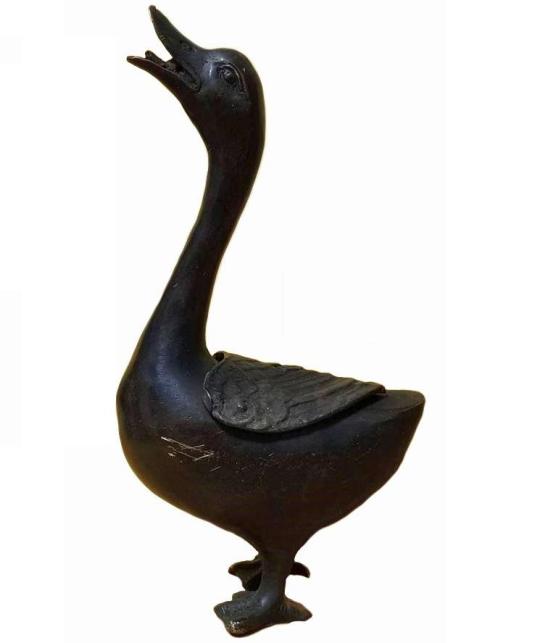
It might be added that most of the oldest tsuri-bune [釣り船] imported from Mogul India and China were originally made as hanging incense burners.
‡This plant is called yomogi [よもぎ = 蓬) in Japanese, and ssuk [쑥] in Korea. In addition to its mosquito-repellent qualities (in Korea, the plant was traditionally cultivated along the edge of the veranda, since even when living the essential oils volatilize into the air, deterring mosquitos; and in the autumn the stalks were cut down to the ground, and then suspended upside-down under the eves to dry for use as a kayari (fumigant) the next year). Mugwort is also used in both country’s cuisine; in Korea, it is also used in certain varieties of traditional sweets (though strongly-flavored sweets of this kind fell out of favor in Japan early in the 20th century -- when the preference shifted to tastes that would best appeal to young women). Mugwort is also used in the traditional medicine of both countries (and the mugwort-flavored sweets were just one example).
**While originally produced as straight incense sticks, the coil version of katori-senkō seems to have appeared during the Edo period as well -- allowing for a longer-burning piece of incense that was not spatially limited as a linear stick would have been.
††The fact that the roji is watered so frequently means that mosquitoes are an inevitable menace from late spring to deep autumn, where they usually attack the participants at the exposed strip of skin between the edge of the tabi and the hem of one’s kimono -- a sensitive area where their bite is horribly annoying (especially in Japan, where the custom is to avoid touching the feet and ankles as much as possible, so the brief relief of scratching is completely out of the question).
⁵Kyū mite, sasuga ni fūryū-no-koto kana to kanshin-shi [休見テ、サスガニ風流ノコトかナト感心シ].
Kyū mite [休見て] means (and) when Rikyū saw this...
Sasuga ni fūryū* no koto kana [流石に風流のことかな] means “indeed, isn’t that most tasteful!” These words were supposed to have been murmured by Rikyū when he noticed the faint tendrils of smoke trailing through the plantings†.
To kanshin-shi [と感心し] means as he was deeply moved (by the sight).
___________
*The expression fūryū [風流], especially as it is being used here, did not enter the lexicon of the chajin until the Edo period (indeed, fūryū was, culturally, a very important and popular way of describing moving, tasteful, and “artistic” experiences from the second half of the seventeenth century onward). This helps us understand that this text, while possibly based on a real incident -- the first time that a kayari-bi was used during a tea gathering to keep the roji and koshi-kake free of insects during night gatherings in the summer -- could not have been written until the late seventeenth century.
†Perhaps it initially reminded him of the smoke of the burning pine needles that trailed through the pine trees during the fusube-chanoyu [ 燻べ 茶の湯] that Rikyū had created for Hideyoshi as a way to enjoy chanoyu even in the pine barrens at Daizen-ji and Hakozaki, during the Kyūshū campaign of 1586~7.
See the post entitled Nampō Roku, Book 7 (66): Fusube-chanoyu [フスベ茶湯] – a Tea Gathering Held Out-of-doors for further details. The URL is:
https://chanoyu-to-wa.tumblr.com/post/726511147567775744/namp%C5%8D-roku-book-7-66-fusube-chanoyu-%E3%83%95%E3%82%B9%E3%83%99%E8%8C%B6%E6%B9%AF
⁶Sono ato, roji・koshikake no atari, ko-kage no shikaru-beki-tokoro ni, kayari wo takare-shi-koto ari [其後、露地・腰カケノアタリ、木陰ノシカルベキ所ニ、カヤリヲタカレシコトアリ].
Sono ato [その後] means after that, later on, afterward.
The implication is that this gathering, hosted by Hino Terusuke, was the first occasion on which a kayari-bi had been used, secreted under the trees to clear the area of noxious insects during the chakai. The realization of how useful this would be is why Rikyū is made to be so impressed and moved -- because he had never though of doing something like that himself*.
Roji・koshikake no atari [露地腰掛の當り] means in an out-of-the-way place in the roji and koshi-kake; on the edge of the roji and koshi-kake.
Ko-kage no shikaru-beki-tokoro ni [木陰の然るべき所に]: ko-kage [木陰], as above, means in the shade of the trees (in other words, in an inobvious place under the trees that were planted to obscure the fences that enclose the roji from view); shikaru-beki-tokoro ni [然るべき所に] means in a suitable place, in the right place.
Kayari wo takare-shi-koto ari [蚊遣を薫かれしことあり] means the fumigant† should be set to smoldering‡ (in the shade under the trees).
__________
*It appears that the burning of kayari originated with, and was largely restricted to, the Imperial Court -- with kayari-bi set up in obscure corners of the various ceremonial and audience halls, to eliminate mosquitoes that would have disrupted the proceedings (since mosquitoes remain active even during the daytime in such large, and dark, spaces, and court ceremonials and audiences could carry on for hours without a break).
†Kayari [蚊遣] -- without the -bi [火] -- means a fumigant or mosquito repellent; however, this short form was also used informally as a way to refer to the kayari-bi, as a self-contained unit, so either interpretation would be correct.
‡This particular verb, takareru [薫かれる], is used specifically to mean to “burn” something like incense -- not with an active flame, but so that it smolders slowly.
==============================================
◎ If these translations are valuable to you, please consider donating to support this work. Donations from the readers are the only source of income for the translator. Please use the following link:
https://PayPal.Me/chanoyutowa
2 notes
·
View notes
Text
I'm not dead, just super inactive :'D
You guys already know about my sis visiting me with her Nintendo Switch and Pokemon Arceus. Well, I'm keeping pause from that game now since I started to play Nioh 1 after a year or so. I've been stuck on this one stage a year or so (Sakon Shima Boss Fight, BSSGUEHJSA!) so I haven't touch the game. I got so depressed since I just couldn't beat Sakon and I tried MANY times with many different ways, equipment etc. for nothing. That man kills you with 1-2 hits!
Well, recently I decided to watch a video (again) how to beat him and I found a video where the player said that Sakon is on level 240... and my William was only at level 130... Yeaaaaah... SURELY I can beat Sakon with that huge level difference! :'D
SO! I decided I will play Nioh and try to level William up at least once per day, hopefully 2 or 3 at times, so that I could have him leveled high enough (255) by the end of this year. In Nioh it's always the Bosses who are pain in the ass, not regular enemies. (I'm already sobbing because of next Boss fight since I know what's going to come, sob sob sob!)
Another thing is my mind had gone and created few new story ideas. One I'm working on (will publish it when it's done) and others are still waiting in my head. Short stories (hopefully) since they are quicker to work with and get out.
Something will come out of me as a new post / update etc. at some point. Just, please, be VERY patient with me! Thank you! <3
3 notes
·
View notes